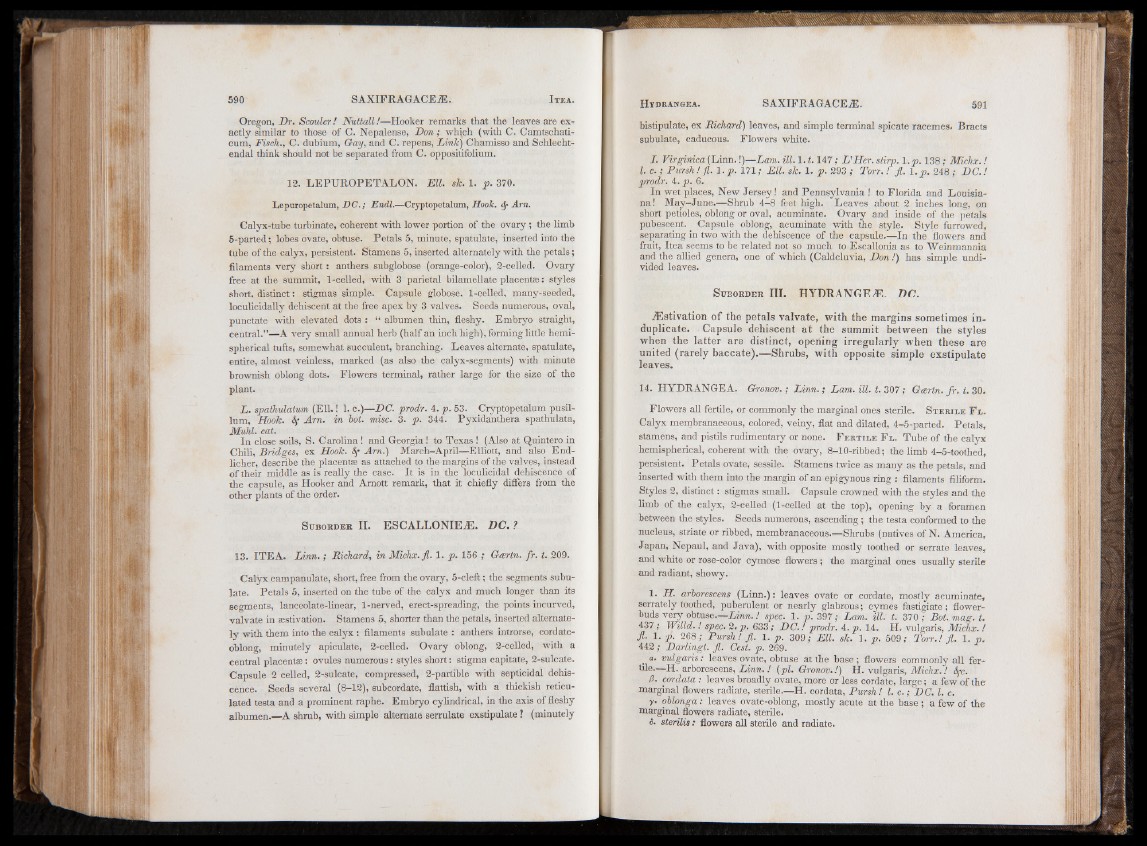
Oregon, Dr. Sander! Nuttall!—Hooker remarks that the leaves are exactly
similar to those of C. Nepalense, Don; wh(ch (with C. Camtschati-
cum, Fisch., C. dubium, Gay, and C. repens, Link) Chamisso and Schlecht-
endal think should not be separated from C. oppositifoiium.
12. LEPUROPETALON. Ell. sk. 1. p. 370.
Lepuropetalum, DC.; Endl.—Cryptopetalum, Hook. dy Am.
Calyx-tube turbinate, coherent with lower portion of the ovary ; the limb
5-parted; lobes ovate, obtuse. Petals 5, minute, spatulate, inserted into the
tube of the calyx, persistent. Stamens 5, inserted alternately with the petals;
filaments very short : anthers subglobose (orange-color), 2-celled. Ovary
free at the summit, 1-celled, with 3 parietal bilamellate placentae: styles
short, distinct: stigmas simple. Capsule globose, 1-celled, many-seeded,
loculicidally dehiscent at the free apex by 3 valves. Seeds numerous, oval,
punctate with elevated dots : “ albumen thin, fleshy. Embryo straight,
central.”—A very small annual herb (half an inch high), forming little hemispherical
tufts, somewhat succulent, branching. Leaves alternate, spatulate,
entire, almost veinless, marked (as also the calyx-segments) with minute
brownish oblong dots. Flowers terminal, rather large for the size of the
plant.
L. spathulatum (Ell. I 1. c.)—DC. prodr. 4. p. 53. Cryptopetalum pusil-
lum, Hook. Sf Am. in hot. misc. 3. p. 344. Pyxidanthera spathulata,
Muid. cat.
In close soils, S. Carolina! and Georgia ! to Texas ! (Also at Quintero in
Chili, Bridges, ex Hook. <$• Am.) March-April—Elliott, and also End-
licher, describe the placentae as attached to the margins of the valves, instead
of their middle as is really the case. It is in the loculicidal dehiscence of
the capsule, as Hooker and Amott remark, that it chiefly differs from the
other plants of the order.
S uborder II. ESCALLONIEiE. DC. 1
13. ITEA. L in n .; Richard, in Michx.fi. 1. p. 156 ; Geertn. fr. t. 209.
Calyx campanulate, short, free from the ovary, 5-cleft ; the segments subulate.
Petals 5, inserted on the tube of the calyx and much longer than its
segments, lanceolate-linear, 1-nerved, erect-spreading, the points incurved,
valvate in aestivation. Stamens 5, shorter than the petals, inserted alternately
with them into the calyx: filaments subulate : anthers introrse, cordate-
oblong, minutely apiculate, 2-celled. Ovary oblong, 2-celled, with a
central placentae: ovules numerous: styles short: stigma capitate, 2-sulcate.
Capsule 2 celled, 2-sulcate, compressed, 2-partible with septicidal dehiscence.
Seeds several (8-12), subcordate, flattish, with a thickish reticulated
testa and a prominent raphe. Embryo cylindrical, in the axis of fleshy
albumen.—A shrub, with simple alternate serrulate exstipulate ? (minutely
bistipulate, ex Richard) leaves, and simple terminal spicate racemes. Bracts
subulate, caducous. Flowers white.
I. Virginica (Linn.!)—Lam. ill. 1 .1.147; L'Her. stirp. l.p . 138; Michx.!
1. c. ; Pursh! fl. 1. p. 171; Ell. sk. 1. p. 293 ; Torr.! fi. l .p . 248 ; DC.!
prodr. 4. p. 6.
In wet places, New Jersey! and Pennsylvania ! to Florida and Louisiana!
May-June.—Shrub 4-8 feet high. Leaves about 2 inches long, on
short petioles, oblong or oval, acuminate. Ovary and inside of the petals
pubescent. Capsule oblong, acuminate with the style. Style furrowed,
separating in two with the dehiscence of the capsule.—In the flowers and
fruit, Itea seems to be related not so much to Escallonia as to Weinmannia
and the allied genera, one of which (Caldeluvia, Don!) has simple undivided
leaves.
Suborder III. HYDRANGEA. DC.
^Estivation of the petals valvate, with the margins sometimes in duplicate.
Capsule dehiscent a t the summit between the styles
when the latter are distinct, opening irregularly when these are
united (rarely baccate).—Shrubs, with opposite simple exstipulate
leaves.
14. HYDRANGEA. Gronov.; L in n .; Lam. HI. t. 307 ; Geertn. fr . t. 30.
Flowers all fertile, or commonly the marginal ones sterile. S terile F l.
Calyx membranaceous, colored, veiny, flat and dilated, 4-5-parted. Petals,
stamens, and pistils rudimentary or none. F ertile F l. Tube of the calyx
hemispherical, coherent with the ovary, 8-10-ribbed; the limb 4-5-toothed,
persistent. Petals ovate, sessile. Stamens twice as many as the petals, and
inserted with them into the margin of an epigynous ring : filaments filiform.
Styles 2, distinct: stigmas small. Capsule crowned with the styles and the
limb of the calyx, 2-celled (1-celled at the top), opening by a foramen
between the styles. Seeds numerous, ascending; the testa conformed to the
nucleus, striate or ribbed, membranaceous.—Shrubs (Datives of N. America,
Japan, Nepaul, and Java), with opposite mostly toothed or serrate leaves,
and white or rose-color cymose flowers ; the marginal ones usually sterile
and radiant, showy.
1. H. arborescens (Linn.): leaves ovate or cordate, mostly acuminate,
serrately toothed, puberulent or nearly glabrous; cymes fastigiate ; flower-
buds very obtuse— Linn.! spec. 1 . p. 397; Lam. ill. t. 370 ; Bot. mag. t.
437 ; Willd. ! spec. 2. p. 633; DC.! prodr. 4. p. 14. H. vulgaris, Michx. !
fi. 1. p. 268; Pursh! fi. 1. p. 309; Ell. sk. 1. p. 509; Torr.! fi. 1. p.
442 ; Darlingt. fl. Cest. p. 269.
a. vulgaris: leaves ovate, obtuse at the base; flowers commonly all fertile—
H. arborescens, Linn. ! (pi. Gronov.!) H. vulgaris, Michx.! &}c.
P. cordata : leaves broadly ovate, more or less cordate, large; a few of the
marginal flowers radiate, sterile.—H. cordata, Pursh! 1. c .; DC. 1. c.
y. oblonga : leaves ovate-oblong, mostly acute at the base ; a few of the
marginal flowers radiate, sterile.
4. sterilis: flowers all sterile and radiate.